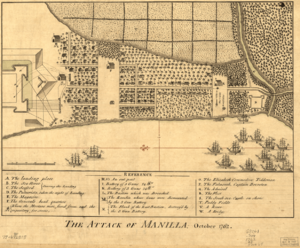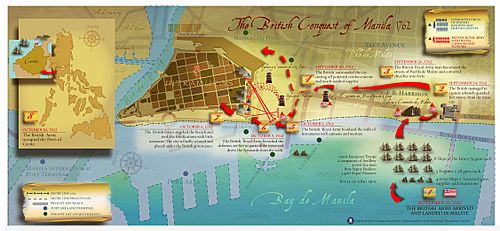Battle of Manila (1762) facts for kids
Quick facts for kids Battle of Manila |
|||||||
|---|---|---|---|---|---|---|---|
| Part of the Anglo-Spanish War (1762–63) | |||||||
 Map depicting where the British landed in Manila with the assault from the south |
|||||||
|
|||||||
| Belligerents | |||||||
| Commanders and leaders | |||||||
| Strength | |||||||
| 10,300 8 ships of the line 3 frigates 4 store ships |
9,356 | ||||||
| Casualties and losses | |||||||
| 147 killed & wounded | 100 killed & wounded 9,256 captured |
||||||
The Battle of Manila was a big fight during the Seven Years' War. It happened from September 24 to October 6, 1762. The battle took place in and around Manila, which was the capital of the Philippines back then. The Philippines was a Spanish colony.
The battle was fought between the Kingdom of Great Britain and the Kingdom of Spain. The British won this important battle. Their victory led to them taking over Manila for about twenty months. This period is known as the British occupation of Manila.
Getting Ready for Battle
The British government decided to invade the Philippines. Colonel William Draper created the plan for this attack. A British ship, HMS Seahorse, was sent ahead. Its job was to stop any ships heading to Manila.
The main British invasion fleet left India in two groups. The first group sailed on July 21. The rest of the fleet, led by Vice-Admiral Sir Samuel Cornish, 1st Baronet, followed on August 1. His main ship was HMS Norfolk.
The British fleet was very strong. It included eight large warships and three smaller frigates. They also had supply ships. On board were 6,839 soldiers, sailors, and marines. Brigadier-General William Draper was in charge of the soldiers. His forces included a special regiment, artillery, and local Indian soldiers called sepoys.
Manila was defended by Spanish soldiers and local Filipino fighters. The Governor-General's guards were there. There were also Spanish marines and artillery experts. Local Filipino fighters from Pampanga also helped defend the city.
The Battle Begins
Vice-Admiral Cornish's fleet arrived in Manila Bay on September 23. There were twelve ships in total. Eight of these ships had more than fifty guns each. They planned to land their troops about two miles south of Manila. Three frigates helped protect the landing.
The landing force had 274 marines. They were led by Colonel Draper and other officers. The next day, 632 sailors joined them on land.
On September 25, the British captured Fort Polverina. After looking around, they saw that Manila's defenses were not very strong. Many parts of the city's walls were not finished. The ditches were incomplete, and some outer defenses had no cannons.
On September 30, a British supply ship arrived. It carried tools for digging trenches. A strong storm pushed this ship ashore. Luckily, it landed in a way that protected the British camp. The supplies could be unloaded quickly and safely.
A big storm started on October 1. This storm made it hard for the British to communicate with their ships. On October 4, about 1,000 local Pampangos attacked a British camp. The British fought them off, and the Pampangos lost 300 fighters. After this, most of the Pampango fighters left the city.
The Spanish defenses grew weaker, while the British attack became stronger. Soon, the British made a hole in the city's walls. On October 6, 60 British volunteers entered through this hole. More soldiers and engineers followed them.
To stop more people from getting hurt, the acting Governor-General, Archbishop Manuel Rojo del Rio y Vieyra, decided to surrender. He gave up both Manila and Cavite to the British commanders, Draper and Cornish.
What Happened Next
The British occupation of Manila lasted for 18 months. Manila was given back to Spain in April 1764. This happened because of the 1763 Treaty of Paris. Spain didn't even know Manila had been lost until after the war ended.
A Spanish official named Don Simon Anda y Salazar went to Bulacan. He organized a Spanish resistance. He gathered an army of 10,000 Filipinos.
During their time in the Philippines, the British mostly stayed in Manila and Cavite. They found it hard to control other parts of the islands. They couldn't fully support local uprisings, like the one led by Diego Silang and later his wife Gabriela Silang. Spanish forces eventually stopped these uprisings.
The British expedition gained a lot of wealth. They captured a Spanish treasure ship called Filipina. This ship was carrying silver from Acapulco. They also captured another Spanish ship, the Santísima Trinidad, which had goods from China. Capturing these ships made both Draper and Cornish very rich. They earned enough money to retire when they returned home.
The British Parliament thanked Draper and Cornish on April 19, 1763. Cornish became a Baronet, which is a special title. Draper later received a Knighthood of the Bath, another high honor.
See also
 In Spanish: Batalla de Manila (1762) para niños
In Spanish: Batalla de Manila (1762) para niños
- List of India-related topics in the Philippines
- Military history of the Philippines


